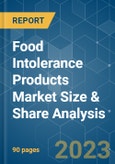The Food Intolerance Products Market size is estimated at USD 19.36 billion in 2023, and is expected to reach USD 28.17 billion by 2028, growing at a CAGR of 7.79% during the forecast period (2023-2028).
Key Highlights
- The demand for natural, organic, and good-for-health food products has significantly increased among consumers in recent years. This increase can be attributed to consumers' growing awareness of the adverse health effects associated with consuming various artificial food ingredients and gluten-containing grains, such as wheat and barley, which are often used in non-complying quantities in food products.
- Medical advancements have also contributed to the growth of the food intolerance products market by providing a solid understanding of the various health benefits associated with these products, enabling consumers to make conscious decisions when purchasing their food products.
- The popularity of the vegan diet, increasing incidences of lactose intolerance, and coeliac disease have continually driven the market for food intolerance products and will continue to do so in the future. Additionally, rising consumer inclination towards labeling and ingredient claims such as 'lactose-free' and 'gluten-free' is also driving the market for these food products.
- Changing lifestyles and growing awareness of the benefits of a vegetarian diet have led to an increase in demand for plant-based foods. Consumers increasingly perceive vegetarian and vegan food products as a way to reduce the levels of harmful cholesterol in the blood and improve health and overall well-being.
Food Intolerance Products Market Trends
Surge in Demand of Clean Label and Free From Ingredients
- The demand for free-from, natural, and organic products is increasing rapidly in various countries. This growth is due to the increased consumer demand for free-from-food products and the rising popularity of clean-label claims on products.
- Many customers are looking for products with specific label claims such as "gluten-free," "dairy-free," "meat-free," "non-GMO," and "reduced sugar." Additionally, products with health claims related to food intolerance, such as cholesterol management and digestion control, are also attracting consumer interest, resulting in higher sales.
- Overall, the trend towards free-from, natural, and organic products is likely to continue as consumers increasingly prioritize health and wellness in their purchasing decisions. Owing to this, the market players are launching new products in the market. For instance, In April 2021, Kellogg's Company launched Incogmeato, a new plant-based Chick'n Tenders by its Morningstar Farms brand. The product is made with non-GMO soy and no artificial flavors. The product comes under two flavors, i.e., original and sweet BBQ.
North America Dominates the Market
- The market is primarily driven by growing consumer interest in health and wellness, clean labeling, and organic foods. For instance, a poll conducted by the International Food Information Council (IFIC) in 2021 revealed that 20% of respondents in the United States frequently purchase packaged foods and drinks because of clean ingredients. As consumers become more health-conscious, they tend to choose nutritious foods such as plant-based dairy or meat.
- Lactose-free foods have become increasingly popular due to the potential health benefits they offer, including weight loss and improved immune systems by enabling precise digestion through lactose-free food products. According to the ProCon Organization, in 2022, 36% of people living in the United States suffered from lactose intolerance. Owing to this, the market players have been launching new products in the market to cater to increasing demand.
- For instance, in January 2023, Califia Farms launched organic almond milk and oat milk in the market. The product contains simple ingredients like purified water, sea salt, and almonds with no added oils or gums. The product claims to be dairy-free and can be used in cereals, smoothies, and bakery products.
Food Intolerance Products Industry Overview
The food intolerance products market is highly competitive, characterized by the presence of many regional players, leading to fragmentation. Some of the key players in this market are Danone SA, Nestle SA, General Mills Inc., Reckitt Benckiser Group Plc, and Beyond Meat, among others. These companies are employing various strategies, such as product innovation, expansions, mergers, and acquisitions, to increase their market share. The leading companies in this market have a diverse product portfolio, including plant-based milk drinks, snack bars, desserts, proteins, and yogurts. To further enhance their positions in the market, these companies can expand their product portfolios within all categories.Additional Benefits:
- The market estimate (ME) sheet in Excel format
- 3 months of analyst support
Table of Contents
1 INTRODUCTION
4 MARKET DYNAMICS
5 MARKET SEGMENTATION
6 COMPETITIVE LANDSCAPE
Companies Mentioned (Partial List)
A selection of companies mentioned in this report includes, but is not limited to:
- General Mills Inc.
- Danone SA
- Blue Diamond Growers
- Abbott Laboratories
- Beyond Meat
- The Kellogg Company
- Reckitt Benckiser Group PLC
- Nestle S.A.
- Oatly Group AB
- Dr. Schar AG / SPA
Methodology

LOADING...










